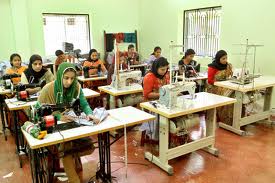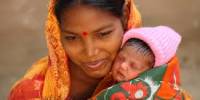Introduction
In recent years, the developing countries of the world including Bangladesh have been focusing attention on the most disadvantaged group in the society – the women. Realization has gradually dawned on all concerned that a society cannot afford to waste half of its human resources by discrimination on grounds of sex. This increasing awareness on the part of the government has led to the adoption of national policies to facilitate a development process involving women in all spheres particularly in economic activities focusing especially on employment development.
Bangladesh in the South Asian Context:
It is well known that women’s employment in South Asia is lower than in any other part of the world except perhaps the Middle East. Bangladesh is at the lower end of the South Asian spectrum and intuitively to those who know the country this seems inexplicable, given that key catalysts of female employment, viz. secondary school education and fertility rates, have had such impressive performance. Unlike other countries in South Asia, however, there has been a sharp growth – an increase of almost one and a half times in women’s employment in Bangladesh in the last decade (1995-2003) coinciding with economic growth and better opportunities.
But rates are still very low at 26 percent for women 15-59 years of age. The gender gap in employment too, while narrowing slightly, still remains very high as male labor force participation is close to universal. However, the prevalence of working for a cash wage is low for both men and women, with less than one fourth of all men and less than four percent of all women working for a cash wage. Unlike other parts of South Asia urban-rural differences in employment rates in Bangladesh are very small and also unlike other countries, urban women tend to be employed more than their rural counterparts. This is due in large part to the lower importance of agriculture in women’s employment as we shall see in the rest of the chapter.
[Calculations based on those working (age 20-55) who received a cash wage in the last week (Bangladesh Labor Force Survey 2002-03)]
The overwhelming majority of women in Bangladesh are not only poor, but also caught between two vastly different worlds-the world determined by culture and tradition that confines their activities inside family homesteads, where they are regarded more as a commodity necessary only for bearing and rearing children and the world shaped by increasing landlessness and poverty that focus them outside into various economic activities for survival. Thus the female members, constituting half the country’s population, are lagging far behind their male counterparts in all spheres of life. In Bangladesh, though the majority of the working women still have not been able to impose a controlling authority in mainstream production, there has arisen a new class – the women employment, who have accepted the challenges of life and have emerged as leaders in the socio-economic development – earning for themselves and for their families or contributing towards the socio-political upliftment of the women. Not only have their greater participation in remunerative work improved their living conditions and provided bargaining positions in the households and wider community, but they are also creating opportunities for the general womenfolk leading to their economic progress and paving the way for a dignified survival through sustainable development. Women have now become aware of their socio economic rights and have ventured to avail the opportunities initiated for them. Rural Bangladesh is now a changed scenario for the women who have gathered courage to break barriers and enter the off-house working force as employment and workers – a situation not accepted by the society in the past. The urban areas have greater opportunities for business development but the areas where women lack assistance is in the access to credit, provision of skill training, and market facilities. Employment today has become an important profession among the women of Bangladesh at various levels of the society, both in the urban and the rural areas.
The reason for the interest varies according to the different classes of the society. Where women of the poorer sections of the society, especially of the rural areas, due to poverty, have been forced into off-house income through employment for economic solvency, the women of the middle class families, who have always lived restricted lives, have today, ventured into this profession as a challenge and an adventure into a new world of economic activity.
On the other hand, many women have taken up employment and become businesswomen not necessarily to earn and survive and raise the living standards, but to form their careers and become professionals in order to establish their rights through the development of a sector and thereby contribute towards the progress of the society and the nation.
[Reprinted from the FBCCI, Journal, Volume 2, Issue 5-6, September- October 2001]
Over the past two decades, norms segregating and protecting women have been breaking down. However, it is also apparent that female economic participation has in fact, marginalized women mainly because the activities involved in many areas does not provide women complete control over production, in land ownership or in income earned. In regular cases, the initiatives in this regard have transferred women from the core production activities to marginal ones, such as handicraft, handloom, or home-based industries than the more sophisticated productions involving modern technology, which are usually controlled by the male employment. Women are not being able to play a controlling role in the mainstream production where the male power has remained intact. No dent is easily created in patriarchy and the patriarchal value system of the society where women have been forced to enter and is involved marginally, being pushed increasingly into problematic situations. Their work load has increased manifold as they have to do both the domestic work and the income earning ones also.
The changing role of women shows that over the last two decades, there has been a steady upward trend in the participation of women in economic activities in developing countries as Bangladesh. Despite the problem of serious under-enumeration of women’s involvement in economic activities in a sex segregated society as ours, the potential of women’s economic contribution is now well recognized.
Greater participation of women in remunerative work is improving their living conditions and bargaining positions in the households and wider community. It is often the case that most of women’s labour in economic activities basically saves expenditure for the household, but women are not considered income earners, as the output of their labour is not always marketed by themselves. The distinct groups of women participation in economic activities outside the homestead are:
(a) Women in rich and moderate male-headed households.
(b)Women in middle and low-income male headed households, and
(c) Women in households headed by females.
The importance of women’s employment development focuses on women’s development in general and their participation in income generating activities in particular, while it deserves a special consideration in rational development planning on two counts. First, leaving the women, who comprise about half the total population, outside the purview of development no nation, can achieve any significant degree of success. It would be like working half strength compared to nations where women make full participation. Secondly, women’s participation in gainful labour is expected to reduce fertility, a common development goal of most developing countries, particularly so for ours.
Women employment in the rural industries is a new arena for investigation in the socio-economic environment of Bangladesh. In view of the need to bring the rural womenfolk in the development stream of the country both the Government, the NGOs and other related agencies have provided ample opportunities to promote entrepreneurial skill among women. Income-generating activities, credit facilities, skill training, market opportunities have all combined to pave the way for the emergence of entrepreneurial development among women in rural Bangladesh.
It takes a long time to get the return from the investment but for the women the main reasons for the continuation of employment was the advantages available and prospects of income derived from the activity. The experience gathered by the women with regard to manufacturing, marketing, management of business and employment generation were of great help and opened up opportunities for expansion of their enterprises. The training facilities offered both by the government and the NGOs increased their efficiency and competency especially in the rural areas. For many, the activity performed by maintaining purdah and within the social restrictions, provided support from the family and the in-laws, as the products manufactured were marketed by the males and the women did not have to tread outside the homestead.
Women have achieved good prospects in industry, especially the small and cottage and micro home-based ones. Their present involvement in manufacturing and in the recent trends of their involvement in construction activities in growing numbers is likely to continue. Women have emerged as exporters and their control of export-oriented industries, are promising areas for enhanced female participation and employment. Incentives could stimulate enterprises to develop female entrepreneurial skills and income-generating activities. Women’s growing involvement in the construction of civil works gives evidence to their potential regarding market growth opportunities and should be encouraged. To stimulate female employment and create further employment opportunities, training programmes for relevant issues, need to be provided to women currently in business. Where women have access to market information and display of products they can increase their business acumen, especially with respect to demand for a wide-range of products they might choose to produce.
With regard to Interventions it is seen that in the present socio-economic situation, with the growing leadership among women in employment, both the Government and the Private Sector interventions such as the NGOs and the other grassroots association have provided women with various facilities to enable them to earn their livelihood and upgrade their conditions, enabling them to gather courage and enough strength to be able to compete with men, especially in the business and employment arena inaccessible to women in the past. The credit supports are provided by various Banks, Government Organisations, Non-Government Organisations, Micro-Finance Institutions and other Credit Co-operatives. Banks are the formal sources for capital for business, though they have failed to reach the poorer section because of their collateral requirements.
Structures of Women’s Entrepreneurial Activities depend on various types. The women have been found to participate in the following:
(1) Self-Employed: These women have acquired on their own, especially from parents, relatives or friends, the skills and capacities to operate enterprises. Some have under-gone training and apprenticeship or worked as skilled labourers and obtained enough knowledge to start their own business. Self-employed women are lesser in urban areas in comparison to rural areas where greater opportunities lie with the income generating activities of NGOs, which provide credit.
(2) Enterprise Ownership: These women, are the
Owner/operators of existing micro-enterprises, and have proven management and technical skill in self-employment. They often wish to expand, upgrade or diversify their business through employment of family members as apprenticeship especially in the rural areas or engage and hire workers for the production when the business progresses in the urban areas. This is the popular structure in the urban areas, where market availability helps the women to develop their trade. Many women working as skilled labourers have ventured to start their own business.
(3) Manufacturing: Women’s traditional skill enable them to take up manufacturing in areas where raw material for the products is easily available. Women in these activities employ workers as skilled, non-skilled, permanent or as seasonal workers. With the expansion of business and the development of quality products, training in skill, technology, management and marketing becomes essential.
(4) Family Trade: Many women are involved in the family trades, hereditarily performed through generations and the skill is traditionally kept within the family. Women in such activities have their enterprises or employment based at homesteads.
Manufacturing handicrafts or pottery, involved in food preparation, operating individual units of embroidery, tailoring printing, dyeing, weaving, spinning, net making, etc., are some of the activities in this structure. These women are helped by family members including males.
(5) Agricultural Activities: The rural women participate more in the agricultural sector, especially in operating vegetable gardens, horticulture production, nursery or even rice husking, and preparation of varied rice products.
(6) Sub-Contracting: This new system of generating income in the non-formal sector is providing opportunities for women through a negotiable procedure obtaining orders for products from either, exporters, producers, whole sellers, and middlemen.
Women even get orders from enterprise owners, who produce their supplementary goods through these women during peak market demands and these continuous orders provide the women with a stable income though the income is not very high, there exits less risks regarding payment.
(7) Partners in Business/ Share holders/ Directors in Family Business Enterprises: Many of the women have become partners or share holders in larger business firms and industrial units. Some have entered the family industrial or business operations.
(8) Traders, Contractors, Order Suppliers, and Business Executives: These new occupations have been mastered by the women even though they have to compete with the men. Though the women have to face tough competitions in these areas, it is remarkable to observe that they have proved themselves efficient in their dealings along with men and have succeeded in their endeavours.
(9) Medium and large Industry Owners: Women have become owners of medium and large industrial units either through inheritance or through private initiative. Many educated women are now the proud owners of shipping companies, tea gardens, trading centres, and advertisement firms.
(10)Export Quality: Women as exporters have ventured into exports directly by themselves or through other exporters. Export fairs, international trade fairs, single country fairs and initiative by importers have helped the women to produce quality products for exports.
Types of Production Units and Trades include the common small scale production units such as Handicrafts with various types of raw materials, Handloom Weaving & Spinning, Basketary, Mat making, Manufacture of Coir products. Fishing Net making, Paddy husking by Dheki, Oil production by Ghani, Jute production and sale, Jute goods production. Pottery, Cane and bamboo products, Seri culture, Silk weaving, Honey Making, Screen print & Batik, Embroidery, Dressmaking. Tailoring, Puffed Rice Making, Food production (packed or retail sale of dry food), Food Processing, Wood craft & Furniture, Molasses making, Biri (indigenous cigarette made with special leaves) production, Milk production units, dairy and milk products, Dyeing and printing, Book Binding, Confectionery, Urea Molasses Block (cattle feed) etc., Nursery and Horticulture production.
Besides these have grown the Agro – based industries and occupations in the rural areas such as: Paddy husking by “dheki, oil production by “ghani” (indigenous oil processor), jute processing, pisci-culture, fishing, fish drying fish processing which are continued with old techniques. Kitchen gardening, poultry rearing (sale of eggs, poultry, chicks), goat and sheep rearing, cattle fattening are common agro-based occupations. Biri (indigenous cigarette made with special leaves) production, bookbinding, production of urea Molasses Block (cattle feed) etc, nursery and horticulture production are being taken up now due to good profits.
Service industries and occupations: Restaurants, (production of snacks, meals, tea, confectionery and Tailoring are now familiar professions both in the urban and the rural areas. Home-based shop-keeping is familiar in the rural areas. Non-Farm Activities:
Cane product and jute carpet making, pigeon rearing for sale, petty trade especially with home-based shops pond lease for fish cultivation and marketing, flower growing for sale to flower shops in the urban areas, fan and cap making.
Small shop keeping, photocopy services, boutique shops, home-based garments making, painting and making of greeting cards, paper-bag making & selling, selling of old tyres, fish and vegetable vending, soap vending, rice cake (pitha) making, road-side food selling shops are some of the urban non-farm activities observed Innovative Products and New Areas: With the introduction of new technology, development of innovative ideas or even demand for new products, a variety of new areas have developed for women’s employment growth. These include, artificial flower making, production of straw caps and hats for export, printing of stationery and cards, vegetable dye products for dyeing and printing, patch-work quilt making, cotton spinning from waste garments, stuffed toys, decorative costume jewellery, manufacture of imitation jewellery. Women have also ventured for artificial pond preparation for shrimp culture, women’s pisci-culture project for both domestic and export marketing.
The distinct groups of women and their participation in off-house activities are, (a) Women in affluent and moderate male-headed households, (b) Women in middle and low-income male headed households, and (c) Women in households headed by females.
Types: Women Employment in the non-formal sector are usually involved in manufacturing, agricultural activities and service oriented activities. In the rural areas, the majority of the employment was members of the NGOs and other grassroots organisations, who had started income through these three types of activities from the loans received. These women were self- employed and worked as
(1) Skilled artisans or self-employed producers
(2) Women traders or Vendors
(3) Whole-sale Suppliers;
(4) Women as partners in Business
(5) Women as share-holder in Business
(6) Women in Family Trade Enterprises
(7) Women as Shop owners
(8) Women as Employers of production units.
Training: Women had received training through NGO activity participation. However, it was found that they usually preferred to use their indigenous skill for employment. The successful women employment held different views when they demanded skill and business management training to expand or introduce new business activities.
Types of Enterprises: The types of enterprises operated by women found were of the following categories: (1) Traditional; (2) Non-tradition; (3) Household or Family Trade; (4) Labour intensive; (5) Export oriented; (6) Industries with modem technology.
Market Areas: The domestic market for non-formal products represents the classical free market structure. It is highly competitive with freedom of entry and exit. Women, especially in the rural areas, had problems of access to market facilities but some did manage to sell in the local market place, to neighbourhood house-holds, to buyers and traders at the house, to order suppliers and the middlemen. They also purchased from producers and sold through markets. The international and the export market areas have been penetrated through international fair participation. Women in the urban areas have greater opportunities for marketing.
Income: Experience gained through years helps women earn higher incomes. The reason for the majority of women in cottage and micro enterprises, earning inadequate monthly income, is likely to be the lack of skill required for running of enterprises and the low level of marketable skills of women as a result of their limited access to education and training facilities. Larger units have greater income which varies according to the business involved.
Micro credit has had direct and indirect impact on employment:
Despite the fact that micro credit can finance only relatively low return self employment and therefore have only imperceptible impact on household income poverty, evaluation studies provide evidence that it does lead to employment expansion, particularly for women.
[ Hossain(1998) ,Rahman 1992, 2000; Rahman and Khandker 1994 cited in Mahmud (2006)]
Bangladesh’s Female Garment Factory Workers:
The urban garments industry is an important component of the Bangladesh economy, as its earnings constitute approximately three-quarters of Bangladesh’s total export earnings. The boom in the urban garments industry has had a major influence on Bangladesh’s female labor market, creating more than one million formal sector jobs for women.
Previously, women with low educational attainment or from rural areas had been confined to the informal labor market, and female formal sector employment had been the preserve of a small educated elite.
However, the garment sector employs only a small share of the total working age population but it has had immense symbolic and real benefits for women’s access to labor markets.
Limitations exist in the form of economic problems and social hazards. Since women are new in certain aspects of employment, they face constraints in many ways, causing hindrances to their regular activities. Male middlemen suppliers, contractors and exporters dominate the industry and take advantage of women’s isolation in the home and lack of access to credit, supplies and knowledge about the economy of their work. Women are handicapped in the current centralized wholesale market set-up controlled by men. Women, due to their physical stature often encounter “mastans”(hoodlooms) rowdy males, whom they find hard to tackle and are stressed to pay money on demand. Women employment is often cheated by their male partners in trade through unscrupulous means which may turn hazardous when apt to encounter. Home-based workers lack access to inputs and services like credit, input supplies, markets and new technology that could increase their productivity. Women observing “purdah”(seclusion) often find it hard to visit banks, purchase their inputs or raw materials or market their product in public settings where they would have to deal with men. Rural women do not generally own physical assets that can be used as collateral for loans, as assets are usually in the names of their male relatives. They are generally poor and lacking in both education and self-confidence. They are perpetually in debt to money-lenders or to wholesale suppliers who create serious problems, thus losing much of their meagre earning in paying exorbitant weekly interest charges. They often suffer the indignities of sexual harassment, being jostled away from prime selling spots. Sometimes their movements are restricted due to security reasons. Women have no legal knowledge or help in protecting their industries and often fall victims to illegal threats or criminal offences.
Problems in business are various. Inadequacy of capital is still the main problem and where available the high interest rates discourage investment. Moreover, non-availability of efficient or skilled labour, absence of marketing facilities for women and the absence of proper sales centre are some of the major obstacles to smooth transactions in business. Besides, products are sometimes put up for sale on credit basis creating problems in the collection of the sale money. Due to lack of storing facilities and space, the women employment suffer serious problems through damage or theft of the products. The prices of products are often kept low because of competition. Other problems arise when the buyer does not provide the actual price or the whole-seller takes goods on credit. Middlemen create problems with regard to low payment. Lack of improved implements and machinery, existing competition faced due to expansion of production, difficulty in the procurement of raw materials, problems of sales collection, problems increased by middlemen, constraints in transportation and marketing are existing problems for business. Besides, lack of management and production skill, lack of healthy workplace environment and especially lack of training facilities are some of the major constraints which should be overcome for steady functioning of the business. Due to lack of market facilities women do not get the proper prices for their products, which are under priced by the customers or wholesalers who order their products
The successes of the women employment have been reflected in their socio-economic developments. The economic solvency and changes in the homestead and the enterprise, speak of their untiring efforts and the urge for a better life. Similar are the social and socio-psychological changes where even the gain in the courage to talk with people regarding business or any trade and the knowledge to distinguish between good and bad investments and transactions, are great achievements.
The natures of changes due to success in business have been observed economically both at the homestead and also within the enterprises or the workplaces. Socially and psychologically, the individual qualitative changes are the most effective for it helps the individual to develop herself through her own initiative and perseverance. Participation in decision making in family matters and also matters of social importance, removal of social seclusion or the religious sanctions against working women and also decrease in social discrimination against these working women are some of the fruitful achievements. Her increase in income is also an increase in the family income, and it provides the family members to have access to a better life-style, including education and better health for the children. Modernization of the work-place, introduction of new technology for increased production, increase of workers, along with the increase in the purchasing power upgrades her status both socially and economically. Increased self-confidence through participation in trade and generation of income had blessed most of these women with a home and a prosperous future.
Sectoral Composition of Employment by Gender (2003)
Sector
| Male | Female | |
| Agriculture/Fisheries | 49.8 | 58.2 |
| Mining | 0.2 | 0.0 |
| Manufacturing | 7.6 | 17.3 |
| Utility | 0.3 | 0.1 |
| Construction | 4.2 | 1.0 |
| Trade, Hotel, & Restaurant | 18.6 | 2.5 |
| Transport, Storage, &Communications | 8.7 | 0.3 |
| Finance & Business | 0.6 | 0.2 |
| Community, Social, & |
Personal Services
9.920.1
Total100.0100.0
Conclusion:
Government and private sector interventions have generally accelerated income generating activities of women both in the urban and rural areas with entrepreneurship development. The ways m which women are involved in this sector in the rural areas are through selling labour (wage labour), engaging in trading activities (self-employment) and operating small industrial productions (enterprise owners). Working as labour may give them temporary employment but it does not improve their conditions or promote their advancement. Scope of trading activities especially in the rural areas, in view of extensive poverty and the large number of people who need to engage in income earning activities, is limited. Engaging in production or rural industrial activities seems to be the most viable avenue for which the women should be assisted to take up. Non-government organizations have equally joined hands with the government efforts for economic salvation and provided various forms of opportunities for women to help them earn their living, paving the way for greater Employment development.
















